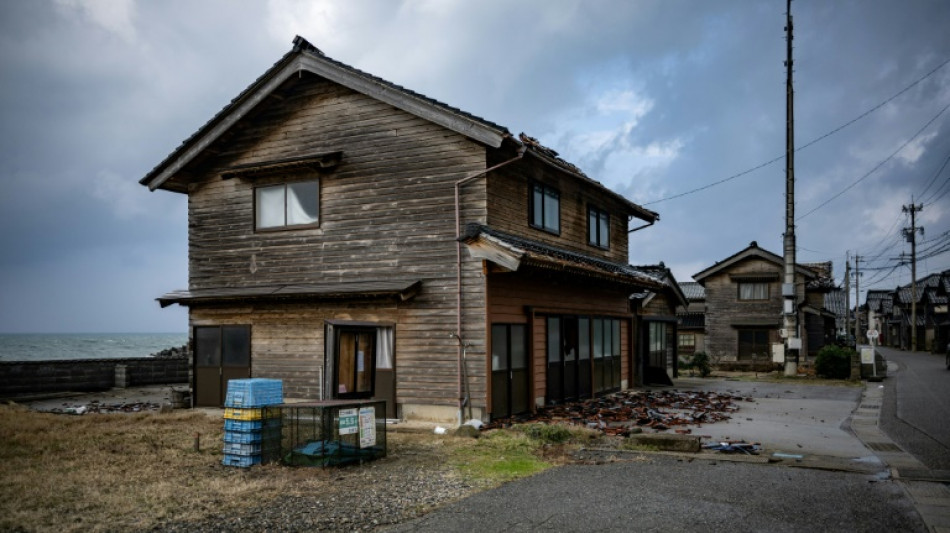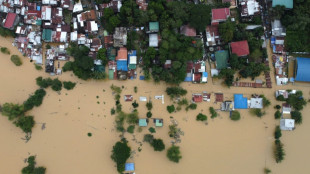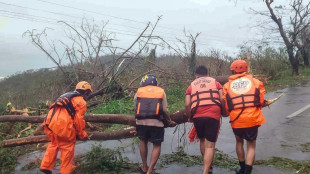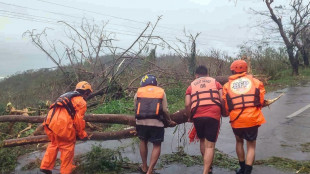
-
 Gazans rebuild homes from rubble in preparation for winter
Gazans rebuild homes from rubble in preparation for winter
-
'Vague' net zero rules threaten climate targets, scientists warn

-
 Stocks, dollar hesitant as traders eye US rate outlook, Nvidia
Stocks, dollar hesitant as traders eye US rate outlook, Nvidia
-
G20 wrestles with wars, climate in run-up to Trump

-
 'Agriculture is dying': French farmers protest EU-Mercosur deal
'Agriculture is dying': French farmers protest EU-Mercosur deal
-
Beyonce to headline halftime during NFL Christmas game

-
 Rescuers struggle to reach dozens missing after north Gaza strike
Rescuers struggle to reach dozens missing after north Gaza strike
-
Russia vetoes Sudan ceasefire resolution at UN

-
 G20 host Brazil launches alliance to end 'scourge' of hunger
G20 host Brazil launches alliance to end 'scourge' of hunger
-
Stocks, dollar hesitant as traders scale back US rate cut bets

-
 Trump confirms plan to use military for mass deportation
Trump confirms plan to use military for mass deportation
-
Schools closed in Beirut after deadly Israeli air raid

-
 Anger, pain in Turkey as 'newborn deaths gang' trial opens
Anger, pain in Turkey as 'newborn deaths gang' trial opens
-
Kremlin says Biden 'fuelling' war as Russian strikes rock Odesa

-
 UN climate chief at deadlocked COP29: 'Cut the theatrics'
UN climate chief at deadlocked COP29: 'Cut the theatrics'
-
G20 leaders gather to discuss wars, climate, Trump comeback

-
 Stocks, dollar mixed as traders scale back US rate cut bets
Stocks, dollar mixed as traders scale back US rate cut bets
-
Stoinis lets rip as Australia crush Pakistan for T20 series whitewash

-
 Bentancur banned for seven games over alleged racial slur
Bentancur banned for seven games over alleged racial slur
-
Kremlin says Biden 'fuelling' tensions with Kyiv missile decision

-
 COP host Azerbaijan jailed activists over 'critical opinions': rights body
COP host Azerbaijan jailed activists over 'critical opinions': rights body
-
Composer of Piaf's 'Non, je ne regrette rien' dies aged 95

-
 South African trio nominated for World Rugby player of year
South African trio nominated for World Rugby player of year
-
'Not here for retiring': Nadal insists focus on Davis Cup

-
 Tractor-driving French farmers protest EU-Mercosur deal
Tractor-driving French farmers protest EU-Mercosur deal
-
Floods hit northern Philippines after typhoon forces dam release

-
 Pakistan skittled for 117 in final T20 against Australia
Pakistan skittled for 117 in final T20 against Australia
-
Schools closed in Beirut after deadly Israeli strike

-
 Chris Wood hits hat-trick in NZ World Cup qualifying rout
Chris Wood hits hat-trick in NZ World Cup qualifying rout
-
Markets mixed after Wall St losses as traders weigh US rates outlook

-
 US, Philippines sign deal on sharing military information
US, Philippines sign deal on sharing military information
-
Bangladeshi ex-ministers face 'massacre' charges in court

-
 Law and disorder as Thai police station comes under monkey attack
Law and disorder as Thai police station comes under monkey attack
-
Disgraced Singapore oil tycoon sentenced to nearly 18 years for fraud

-
 Philippines cleans up as typhoon death toll rises
Philippines cleans up as typhoon death toll rises
-
Quincy Jones awarded posthumous Oscar

-
 'Critically endangered' African penguins just want peace and food
'Critically endangered' African penguins just want peace and food
-
Long delayed Ukrainian survival video game sequel set for release amid war

-
 Star Australian broadcaster charged with sex offences
Star Australian broadcaster charged with sex offences
-
Philippines cleans up after sixth major storm in weeks

-
 Woman-owned cafe in Indonesia's Sharia stronghold shakes stigma
Woman-owned cafe in Indonesia's Sharia stronghold shakes stigma
-
Indigenous Australian lawmaker who heckled King Charles censured

-
 End of an era as Nadal aims for winning Davis Cup farewell
End of an era as Nadal aims for winning Davis Cup farewell
-
Trump taps big tech critic Carr to lead US communications agency

-
 Mitchell-less Cavs rip Hornets as perfect NBA start hits 15-0
Mitchell-less Cavs rip Hornets as perfect NBA start hits 15-0
-
Markets swing after Wall St losses as traders weigh US rates outlook

-
 India's capital shuts schools because of smog
India's capital shuts schools because of smog
-
Rio under high security for G20 summit

-
 G20 leaders to grapple with climate, taxes, Trump comeback
G20 leaders to grapple with climate, taxes, Trump comeback
-
Hopes set on G20 spurring deadlocked UN climate talks


Still standing: unique houses survive quake in Japan village
The New Year's Day earthquake demolished wooden buildings all across Japan's Noto Peninsula but thanks to decades-old smart architecture, one small fishing village stood strong.
A few roof tiles came loose but not one of around 100 structures in windswept Akasaki, on the stick of land's western coast, collapsed in the magnitude 7.5 quake whose epicentre was just a few kilometres (miles) away.
Masaki Sato drove all night from his home 300 kilometres (190 miles) away in Tokyo after the quake to check on the 85-year-old house that he has owned since 2017 and runs as a summer B&B.
"The house stands on a very narrow lot of land, and the building has many small rooms, with many columns" that make it stronger, the 43-year-old told AFP.
To withstand the harsh rain, snow and ocean winds buffeting off the Sea of Japan, Sato's house and most others in Akasaki have few glass windows.
Their exterior walls are made from sturdy wooden slats, layered horizontally. The structure is supported by thick beams criss-crossing the ceiling.
The earthquake and its many aftershocks killed at least 161 people, and 103 others are still missing, authorities said on Monday.
But there were no casualties in the tight-knit village.
Even tsunami waves triggered by the earthquake didn't reach the houses, which are built on land slightly uphill from concrete tetrapods that protect them from the sea.
At Sato's place, ceramic dishes smashed, appliances toppled and a recently added wooden sliding door broke, leaving debris strewn across the floor.
But that was it.
"I felt so encouraged, because the village was still there standing," Sato said.
"I think it's thanks to the design of the houses," he added, sitting at the dusty but still solid kitchen counter in his guest house.
- 'Windshield' -
The same lucky outcome was seen around the village, where "the design of the houses is more or less the same," said resident Seiya Shinagawa, a retired fisherman.
"Traditionally there's a shed on the coast as a windshield, with a narrow main house behind it," the 78-year-old said.
This setup is a remnant of the days when each fisherman would launch their boats out of their shed directly to the sea, Shinagawa said.
From around the 1920s, the community's fishermen opted for more lucrative deep-sea fishing far away from home, sometimes hauling in small fortunes for their catch.
But when a fire broke out and destroyed a significant part of the village in the late 1930s, people rebuilt the houses in a unified and stronger design.
- Demographic threat -
Now despite its resilient character, the village faces a problem that is widespread in Japan: a severely ageing population.
Most people in Akasaki are over 65, with many living alone, including 74-year-old resident Akiyo Wakasa.
"My neighbour and their next-door neighbour also live alone," she said.
According to Wakasa, part of the problem is that "fixing houses costs money".
"I'm not sure how many people here actually think it would be worth fixing the house and continuing to live here when they have nobody to hand it down to," she explained.
For Sato, an IT firm employee who runs a real-estate renovation business on the side, seeing Akasaki entering a slow decline is unbearable.
The area is not recognised by the government as a cultural asset, but it's a place where people lead a simple, old-fashioned lifestyle, he said.
And when there's no one to live in a house, it's torn down -- eroding the village's charm, according to Sato.
"Akasaki, which has preserved a unique and uniform housing design... is losing its scenic appearance."
To save Akasaki's special look, Sato has purchased five of the houses and sheds himself, and wants eventually to open some cafes and restaurants there.
"The village is too precious to lose," he said.
T.Sanchez--AT


